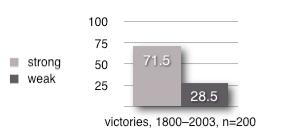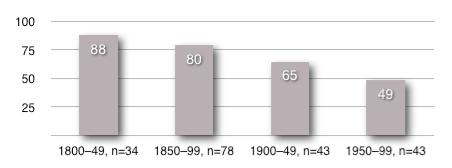| Home | Blog | Ask This | Showcase | Commentary | Comments | About Us | Contributors | Contact Us |

How a superpower can end up losing to the little guysCOMMENTARY | March 82, 2007A Harvard scholar explores the implications of his recent research on asymmetric conflicts, which shows that strong actors are losing to the weak more and more often over time, and gleans some important lessons about the United States and Iraq. (First of two parts.) By Ivan Arreguín-Toft Asymmetric conflicts such as the one the U.S. is currently fighting in Iraq have been an enduring feature of international politics. On the other hand, what we know about them as a type of armed conflict – why they start, how they are fought, how they end, and why – has only recently become the focus of rigorous scientific inquiry. Since the U.S. is involved in an asymmetric conflict in Iraq, a review of what we know about such conflicts may shed some light on our fate there. A first fact about asymmetric conflict is that if power is defined as most commonly understood in the last two hundred years – size of armed forces, level of technology, population size, and geographic size – then a count of wins and losses for strong actors over the last two hundred years makes it clear that having a large power advantage over your rivals in a fight is a good thing to have. Figure 1: Percentage of Asymmetric Conflict Victories, 1800–2003
Figure 2: Percentage of Asymmetric Conflict Victories Over Four 50-Year Periods
It turns out there is. When divided into four 50-year periods, we see that strong actors are losing to the weak more and more often over time; so much so that by the final 50-year period, the weak won a majority of engagements with actors ten times more powerful. The implication of this finding is striking: although relative power matters, and on balance it appears to be the decisive factor in explaining outcomes, Figure 2 makes it clear that it is only one factor, and that by itself relative power is not sufficient to explain outcomes. Something else must be going on. What is going on is the interaction of strategies deployed by the different sides engaged in the war. Whereas strong powers excel at defeating weak ones in conventional, direct fights, they fare less well in guerrilla, indirect fights. Strong western powers adapted themselves in doctrine, training, and equipment to excel at a style of warfare that worked in WWII: large, mechanized, combined-arms militaries directly engaging each other across relatively open terrain. By contrast, Mao’s victory in China made “revolutionary warfare” seem the ideal style of warfare for small powers. Small powers adapted themselves to fight insurgency campaigns, challenging their more advanced adversaries with an indirect strategy that traded the protection of population for time. The interaction of the two strategies favors insurgents. This interaction of strategies – conventional-direct versus unconventional-indirect – marked the French attempt to re-establish control of Indochina, the Americans against the Vietcong, and the Soviets against the Afghans. In each of these asymmetric conflicts, the insurgents won using unconventional-indirect strategies, and this pairing is reflected in the general trend highlighted above; a trend that has continued in the U.S. conflicts in Afghanistan and Iraq. In Afghanistan, the United States swiftly defeated the main elements of the Taliban using special operations forces in support of Afghani Northern Alliance troops. The Taliban were forced to fight with a conventional-direct strategy, and lost. In the first month of Operation Iraqi Freedom, U.S. forces again engaged a hostile adversary attempting to defend Iraq with a conventional-direct strategy, and U.S. forces quickly won. Now the U.S. facing an unconventional-indirect defense, and public opinion has turned against the war. If history is any guide, the insurgents are likely to win. .
|
|||||||||||





